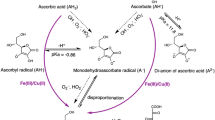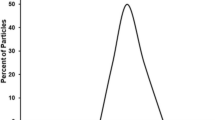Abstract
Chromium is a known allergen and carcinogen, but the mechanisms by which damage is caused are not clearly understood. Based on experimental literature, we devise a conceptual model examining the intracellular reduction of chromium through reductants such as glutathione and ascorbic acid. From this, we build a mathematical model describing these events in detail and we use this to clarify the key steps in the process of chromium reduction within cells.
In particular, we consider the free radicals which are generated as a result of chromium reduction and that are likely to cause most harm to the cell. To explore the practical implications of the model predication, we investigate what the effects of a single eight hours of exposure and multiple eight hour exposures over the course of 3 days with increasing extracellular chromium concentration are. The dependence on initial chromium concentration is of particular significance with the proportions of the various chromium states changing as well as free radical generation increasing with greater chromium exposure.


















Similar content being viewed by others
References
Bagchi, D., Stohs, J., Downs, B., Bagchi, M., & Preuss, H. (2002). Cytotoxicity and oxidative mechanisms of different forms of chromium. Toxicology, 180, 5–22.
Chen, F., Vallyathan, V., Castranova, V., & Shi, X. (2001). Cell apoptosis induced by carcinogenic metals. Mol. Cell. Biochem., 222, 183–188.
Cieslak-Golonka, M., & Daszkiewicz, M. (2005). Coordination geometry of Cr(VI species: structural and spectroscopic characteristics). A review. Coord. Chem. Rev., 249, 2391–2407.
Codd, R., Dillon, C., Levina, A., & Lay, P. (2001). Studies on the genotoxicity of chromium: from the test tube to the cell. Coord. Chem. Rev., 216–217, 537–582.
Dayan, A., & Paine, A. (2001). Mechanisms of chromium toxicity, carcinotgenicity and allergenicity. Review of the literature from 1985 to 2000. Hum. Exp. Toxicol., 20, 439–451.
Green, D., & Kroemer, G. (1998). The central executioners of apoptosis: caspases or mitochondria? Trends Cell Biol., 8, 267–271.
Lamb, A. (2009). Mathematical modelling of the biological streess response of chromium. PhD thesis, The University of Nottingham.
Lamb, A. (2012). Mathematical modelling of chromium induced dna damage.
Levina, A., & Lay, P. (2004). Solution structures of chromium(VI) with glutathione and model thiols. Inorg. Chem., 43, 324–335.
Levina, A., & Lay, P. (2005). Mechanistic studies of relevance to the biological activities of chromium. Coord. Chem. Rev., 249, 281–298.
Levina, A., Codd, R., Dillon, C., & Lay, P. (2003). Chromium in biology: toxicology and nutritional aspects. Prog. Inorg. Chem., 51, 145–250.
Little, M., Gawkrodger, D., & MacNeil, S. (1996). Chromium- and nickel-induced cytotoxicity in normal and transformed human keratinocytes: an investigation of pharmacological approaches to the preventrion of Cr(VI)-induced cytotoxicity. Br. J. Dermatol., 134, 196–207.
Liu, K., & Shi, X. (2001). In vivo reduction of chromium(VI) and its related free radical generation. Mol. Cell. Biochem., 222, 41–47.
Liu, K., Husler, J., Ye, J., Leonard, S., Cutler, D., Chen, F., Wang, S., Zhang, Z., Ding, M., Wang, L., & Shi, X. (2001). On the mechanism of Cr(VI)-induced carcinogenesis: dose dependence of uptake and cellular responses. Mol. Cell. Biochem., 222, 221–229.
Morton, J., Jones, A., Balaga, C., MacNeil, S., & Gawkrodger, D. (2004). Investigation into the effects fo nickel and chromium upon an in vitro human skin model (Tech. Rep. BM/2004/03). Health and Safety Laboratory and University of Sheffield and Royal Hallamshire Hospital.
Quievryn, G., Goulart, M., Messer, J., & Zhitkovich, A. (2001). Reduction of Cr(VI) by cysteine: significance in human lymphocytes and formation of DNA damage in reactions with variable reduction rates. Mol. Cell. Biochem., 222, 107–118.
Quievryn, G., Messer, J., & Zhitkovich, A. (2006). Lower mutagenicity but higher stability of Cr-DNA adducts formed during gradual chromate activation with ascorbate. Carcinogenesis, 27(11), 2316–2321.
Shi, X., Chiu, A., Chen, C., Halliwell, B., Castranova, V., & Vallyathan, V. (1999). Reduction of chromium(VI) and its relationship to carcinogenisis. J. Toxicol. Environ. Health, 2, 87–104.
Singh, J., Carlisle, D., & Pritchard, D. (1998). Chromium-induced genotoxicity and apoptosis: relationship to chromium carcinogenesis (review). Oncol. Rep., 5, 1307–1318.
Valko, M., Rhodes, C., Moncol, J., Izakovic, M., & Mazur, M. (2006). Free radicals, metals and antioxidants in oxidative stress-induced cancer. Chem.-Biol. Interact., 160, 1–40.
Zhitkovich, A. (2005). Importance of chromium-DNA adducts in mutagenicity and toxicity of chromium(VI). Chem. Res. Toxicol., 18(1), 3–11.
Zhitkovich, A., Peterson-Roth, E., & Reynolds, M. (2005). Killing of chromium-damaged cells by mismatch repair and its relevance to carcinogenesis. Cell Cycle 4, 8, 1050–1052.
Acknowledgements
The first author gratefully acknowledges the funding of the EPSRC and HSL in the form of a CASE studentship and for additional funding provided in the form of IRP funding; the second author that of the Royal Society and Wolfson Foundation.
Author information
Authors and Affiliations
Corresponding author
Rights and permissions
About this article
Cite this article
Lamb, A., Evans, G. & King, J.R. Mathematical Modelling of Toxicity Associated with Intracellular Chromium Reduction. Bull Math Biol 75, 1472–1500 (2013). https://doi.org/10.1007/s11538-013-9856-z
Received:
Accepted:
Published:
Issue Date:
DOI: https://doi.org/10.1007/s11538-013-9856-z




